News
Style Guide for Authors
more
Financial Statement of 2019
more
Available Now! Down Fell the Statue of Goliath - Hungarian Poets and Writers on the Revolution of 1956
more
Subscription
Hungarian Review annual subscriptions for six issues, including postage (choose one):

14 January 2016
Black Land
"As a Hungarian, Stefan and his family may have faced discrimination in Czechoslovakia. As Catholic “Hunkys”, they definitely faced discrimination in the United States as it was during the first half of the twentieth century. The Ku Klux Klan, today associated in the American mind with segregation, lynching and other discriminatory actions against African-Americans, burned a cross near my Catholic grandfather’s house…"
Steve Revy, as Stefan Révay was known in later life, helped a number of his wife’s relatives come to the United States, and often received little thanks for his troubles. His sons and daughters largely assimilated to life in the United States, with just a few of his children or grandchildren showing much interest in the so- called “Old Country”, which was now divided into Hungary, Czechoslovakia (later Slovakia and the Czech Republic) and Poland. In addition, huge barriers between those who stayed in Central Europe and those who came to the US developed: World War I, with Austria–Hungary suddenly an enemy of the United States; laws that drastically reduced immigration into the US from countries outside of Northern Europe during the 1920s; World War II; and, then, more than four decades of Soviet occupation and the “Iron Curtain”.
This is a typical story, and one that would have been well-known, even cliché, in American literature of the 1940s, 50s and 60s. I wrote Passage for at least two reasons; because those of my age or younger are so Americanised that they are beginning to forget this story; and because this story is being played out again in the United States of our time, but the language is Spanish, not Hungarian, Slovak or Polish; and the “Old Country” is in Latin America, not Central Europe.
My recent book of poems, Passage (Oak Ridge, Tennessee: Iris Press, 2015), looks at immigration to the United States through the lens of my family’s experience. My grandfather, István or Stefan Révay, left what is now Slovakia in the 1890s and came to the United States to better his life. He later sent for a Slovak woman, Maria Soltis, in what was apparently an arranged marriage, and they wed immediately after she arrived in the United States. In Passage, I write about this from Maria’s point of view:
DANCING THE CSÁRDÁS
I swore I’d never step
on a big ship again.
The swaying, dim light
below decks, people seasick.
And on and on we sailed.
Father said He’s a big man,
a Magyar, doing well in America –
and I thought I could remember
the boy running by our house.
Mother closed my hope chest,
said goodbye at the station.
Father went with me,
and brother János, to Fiume
on the smoke-spitting train.
And, at the Island,
when I got through,
he was there, standing
at the bottom of the stairs.
Then the train, the church,
it was done.
A life – a good life?
I guess it was.
He was a good man –
we had children,
some moved on, some
stood by us
at the end.
The work was hard, long,
but we danced the csárdás
when we could.
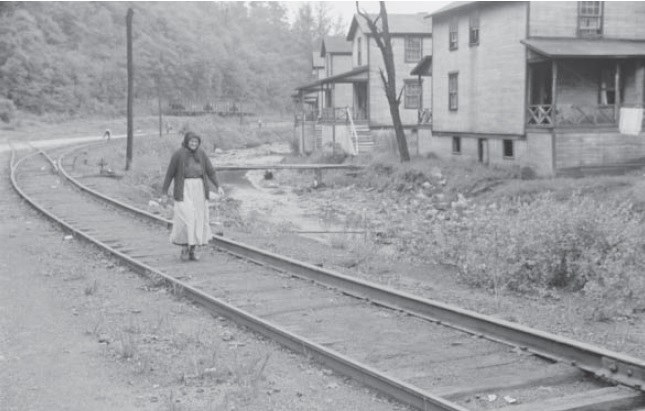
Woman (probably Hungarian) coming home along railroad tracks in coal mining town, company houses at right, Pursglove, Scotts Run, West Virginia. Marion Post Wolcott, September 1938 (Library of Congress, Prints & Photographs Division, FSA-OWI Collection, LC-USF33-030285-M1). This is the cover photo for Passage, reversed there for artistic reasons. This woman looks like my grandmother; one of my cousins, when she saw the cover, asked if this was my grandmother.
Steve Revy, as Stefan Révay was known in later life, helped a number of his wife’s relatives come to the United States, and often received little thanks for his troubles.(1) His sons and daughters largely assimilated to life in the United States, with just a few of his children or grandchildren showing much interest in the so- called “Old Country”, which was now divided into Hungary, Czechoslovakia (later Slovakia and the Czech Republic) and Poland. In addition, huge barriers between those who stayed in Central Europe and those who came to the US developed: World War I, with Austria–Hungary suddenly an enemy of the United States; laws that drastically reduced immigration into the US from countries outside of Northern Europe during the 1920s;(2) World War II; and, then, more than four decades of Soviet occupation and the “Iron Curtain”.
This is a typical story, and one that would have been well-known, even cliché, in American literature of the 1940s, 50s and 60s. I wrote Passage for at least two reasons; because those of my age or younger are so Americanised that they are beginning to forget this story; and because this story is being played out again in the United States of our time, but the language is Spanish, not Hungarian, Slovak or Polish; and the “Old Country” is in Latin America, not Central Europe.
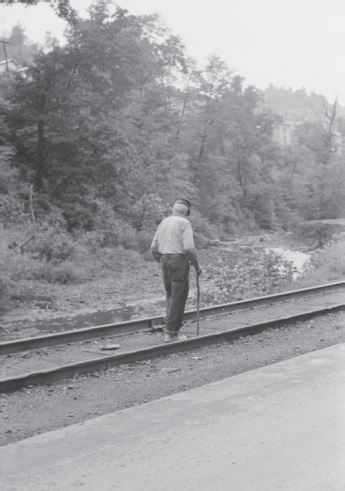
Untitled photo, related to: Old man, Hungarian, with cane, going home after work along tracks, Pursglove, Scotts Run, West Virginia. Marion Post Wolcott, September 1938 (Library of Congress, Prints & Photographs Division, FSA-OWI Collection, LC-USF33-030285-M2). And this man looks like my grandfather. I like to imagine that these two are an old married couple; the photos were taken closely together, we can tell that from their call numbers.
But this essay is written for an audience largely formed of English-speaking Hungarians. You know the story I just outlined; and you probably know it better than most readers in the United States. But what you might not be familiar with – they are certainly not places that people visiting the US usually go – are the communities where Hungarians and other Central Europeans settled after coming to the US; what they did there; and what has happened to those towns and cities in an era of American deindustrialisation, combined with a long decline in a number of American extractive industries, including coal mining, lumbering and iron mining.(3)
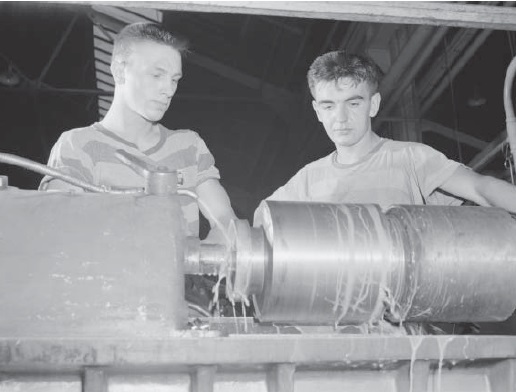
Manpower. Americans all. Operating a low-swing engine lathe, Joe Zorich (left) and Chuck Doe, both nineteen, are typical of the younger workers in this huge Midwest medium-tank factory. Both are first-generation Americans – Joe’s parents came from Croatia and Chuck’s from Germany – and both are just about as American as any nineteen-year-old who can count his American-born ancestors on both hands. Machining parts for the tanks American soldiers will use to defeat the Axis, they’re marking time till they can be on the front lines themselves, using these very tanks to make a first-hand stab at Hitler’s hordes. Pressed Steel Can Company, Chicago, Illinois. Ann Rosener, September 1942 (Library of Congress, Prints & Photographs Division, FSA-OWI Collection, LC-USE6-D-005958). The Farm Security Administration/Office of War Information collection contains few images of steel workers with the workers’ ethnicity identified. Here is one with a young Croatian man.
Given the relative ease of our lives today, it is hard to believe that millions made the so-called “hazardous quest” to the United States to better their lives through work opportunities in occupations such as steel-mill worker or coal miner. But that is what the Central Europeans I wrote about in Passage did; and these occupations, being stereotypical for Hungarian immigrants, are those that I will highlight here.(4)
Central Europeans who worked in the steel mills went where that industry was concentrated: Pennsylvania and Ohio. This is why, if you look at the Hungarian– American population in the United States today, about 1.5 million people,(5) Ohio has the largest group (the other states with large populations are New York, California, Pennsylvania, New Jersey and Michigan, in that order).(6) Prominent Ohio cities with large Central European communities include Cleveland, Toledo and Youngstown.
Although several members of my family went to live amongst their co-ethnics and Catholic co-religionists in Youngstown, it was not their fate to work in the steel mills. But, in Youngstown, they lived in a community that depended on the steel industry almost completely. When almost all steel milling in the United States, with the exception of the “mini” technology pioneered by Nucor Corporation, collapsed, Youngstown was devastated. “Puszta”, in Passage, as does a well-known song by Bruce Springsteen, “Youngstown”, looks at what remains:
PUSZTA (Waste)
Scrap paper drifts across the parking lot
where furnace blasts once lit the sky.
Empty windows in the strip mall
gape at the road.
The hotel’s an old folks home – a man
mumbles on the stoop.
The train station’s a thrift store, tracks pared
from many to one.
And the Paprika Restaurant’s now
a greasy spoon –
Fires laid down, seven hundred
tons of steel a day
crumble to rust.
The other Ohio city famous for its Hungarian community was Cleveland. Although Cleveland has weathered deindustrialisation more successfully than Youngstown, the decline of its traditional industries and communities decimated the city’s Hungarian–American heritage. The count of Hungarian-Americans in Greater Cleveland dropped, according to The Encyclopedia of Cleveland History, from 113,000 in the 1980s to 61,681 in 1990.(7)
In Passage, I imagine a man who came to the US with his family to work in the steel mills. The poem is from the point of view of his son, now a grandfather, revisiting Ellis Island seven or eight decades later:
ELLIS ISLAND FERRY
I’m remembering it – bedlam. The
stinking launches, blue-coat
officers like Emperor’s men.
Lines, screaming ones
turned away. At the end, railroad
men, more blue-coats, one-way
tickets to the Youngstown mill.
My father’s neck, pitted with
deep round burns,
told the rest of the story.
Today, we stand in the ferry’s bow,
the waters purr by. I squeeze my
granddaughter’s hand, my fingers
a creaking claw. She looks up,
sharp – I’m hurting her. How to
tell about the stench, the massed
people. I was a snip of a thing,
too young to hope.
The gorge of my fear rises
as we step off the boat; the
fear takes my eyes and I turn
from the little one to hide my
old face, now young, a boy
again, dirty, hungry, here.
If it was not my family’s fate to labour and burn, in the steel mills of Ohio, it was certainly their destiny to breathe coal dust and dodge rock falls in the bituminous coal mines of western Pennsylvania. Although we do not know where Stefan Révay first worked in the United States – there are stories of a bar fight in Detroit, Michigan, and fights with the Coal and Iron Police somewhere in Pennsylvania, as well as a role for Stefan as a union organiser – we know that he was to settle in the small coal-mining towns, such as Nanty Glo, Spangler and Barnesboro, near Ebensburg, Pennsylvania. We also know that he would bring at least three male relatives or in-laws over to work in the mines. Two of his sons would work in the mines, albeit briefly, and two would escape without going into the mines at all. According to family stories, several of his daughters’ husbands would work in the mines, as would many male members of the extended Révay/Reevy/Revy and Soltis families.(8)
The cover of Passage (see Illustrations 1 and 2) shows a Hungarian woman, in a mining community in West Virginia, that reminds me of my grandmother; and the companion photo shows a man, possibly her husband, who is reminiscent of my grandfather.(9)
In Passage, I imagine Stefan as a union (United Mine Workers, or UMW) organiser:
UMW STRIKE
The Cossacks, Yellow Dogs, rode us
down, flailing with clubs. I saw
one reach for his holster.
Couldn’t spare their horses
any more. Dumped my tin
bucket – the ball bearings
toppled their mounts. We
stepped up with pick handles,
baseball bats. Put our muscles,
swollen from loading tons
a day, to work against
blue-hatted heads.
Immigrant stories are more complex than American folklore would have it, and Stefan Révay’s tale is no exception. He waited until he was about thirty, late for the time, to marry. He started in the US as a miner; but, by the time of World War I, Stefan owned a small mine and boarding house in a lost Pennsylvania community known as “Thirteen”. I have not been able to find this place; my uncle Charlie, apparently the last family member who knew its location, took that information with him, apparently forever, when he died three decades ago:
THIRTEEN
Some say it was a trolley stop
thirteen halts out of Barnesboro
– others tell of a shaft
between mines Twelve and Fourteen.
Charlie scouted out the foundations –
the long, narrow one a boarding house,
the squat squares miners’ homes
– and flat slip of vanished railroad
speckled with ballast stones.
It was his last hunting trip
to the old homeplace
before black lung and cigarettes
cut him down.
He couldn’t find the mine,
its black mouth gaping
for men to enter.
When November mist rises
in those Pennsylvania hills
it can still seem that
something’s there.
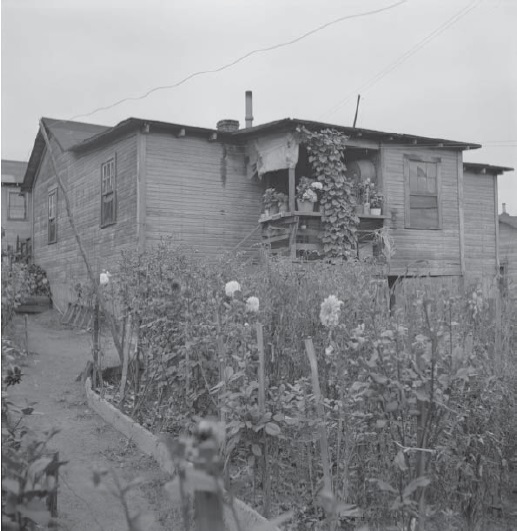
Rear of coal miner’s home (Hungarians usually have nice gardens and canned goods). Chaplin, West Virginia. Marion Post Wolcott, September 1938 (Library of Congress, Prints & Photographs Division, FSA-OWI Collection, LC-USF34-050066-E).
The story becomes even more complicated after World War I. Then, Stefan decided to take his family back to his hometown of Dobsina. With the treaty of Trianon, this town was no longer located in Hungary; it was in the Slovak portion of a new country, Czechoslovakia. Stefan faced family divisions; bought a house that had been, according to family legend, previously owned by a pro-Habsburg “royalist”;(10) and, given his Hungarian family name, undoubtedly faced suspicion, perhaps discrimination, from the new government. My father, originally Stefan Révay, now William R. “Bill” Reevy, was born in then-Czechoslovakia during this part of the family’s life experience. The elder Stefan soon decided to return to the United States, and he could do so fairly easily since he had taken “first papers” while in the United States:
FIRST PAPERS
Declarations of Intention (or First Papers). Normally the first papers were completed soon after arrival in the US, depending on the laws in effect at the time.
When I looked from the window,
hearing the sound of horses,
I saw the gendarmes
sent by my own brother
at the gate.
Knew the last owner of my house,
a royalist – and the flat
wooden cases of rifles
buried in the yard.
The land was ours no longer
– I blessed the day
I’d signed papers saying
I could stay in a new land
if I lived.
Clash of gun butt
against wood told me
it was time
to open the door.
By 1923, the entire family, including my father, was back in the United States, and had returned to Nanty Glo, a mining town in the bituminous region of western Pennsylvania.(11) Stefan returned to the mines, but after an accident during the mid-1920s, he bought a farm. In “The Mule Driver Leaves the Mine”, I imagine the aftermath of the accident; my grandfather was a mule driver in the mines at the time he decided to leave them, and the mishap crippled his leg (the death of the mule is my addition to the story):
THE MULE DRIVER LEAVES THE MINE
It was Klara I cared for
in that dark hole.
When the rock fall
took her, it got my
leg – but I could
have worked on.
The mines are not
my place anymore.
Owning a farm, and the food it supplied, was to sustain Stefan’s family through the Great Depression, which hit six years after their return to the United States.
As a Hungarian, Stefan and his family may have faced discrimination in Czechoslovakia. As Catholic “Hunkys”, they definitely faced discrimination in the United States as it was during the first half of the twentieth century. The Ku Klux Klan, today associated in the American mind with segregation, lynching and other discriminatory actions against African-Americans, burned a cross near my Catholic grandfather’s house:
BURNING
Anti-Catholicism was widespread in the 1920s; anti-Catholics, including the Ku Klux Klan, believed that Catholicism was incompatible with democracy and that parochial schools encouraged separatism and kept Catholics from becoming loyal Americans.
Sudden night-fire-cross,
like unwanted sun,
flames on hill crest
crowning home vale
and farm fields.
Horses snort in their stalls.
Dog barks at the
unseen invader.
Mother stares out
the window, murmurs
in Slovak,
poď sem, shelters
the boy
under her full skirt.
Sometime during the period from about 1905 to the mid-1920s, Stefan brought family members, most notably brother-in-law Albert Soltis, to the United States. Sometimes, this didn’t work out as expected. A family story about Stefan and one of his brothers was the genesis for a poem in Passage, “The Debt”:
THE DEBT (A tartozás)
Creosote smell, ties spaced
just wrong for my
footfalls. Mama walking
the rails with me, thirteen
miles to Portage. No
train today, mines running
just twice a week.
Uncle’s house, doilies
under the lamps. But Mama
and me come back
with no money. Pap,
yelling, Never go there
again. I paid his way
to Amerika. He’s no
brother of mine now.
I run out to the spring,
watch the crystal water
spill and gurgle, hold
my hand in till
it’s numb.
The last members of my extended family who were miners were descendants of these relatives that Stefan sponsored, allowing them to immigrate to the US. One of these descendants, my cousin George (or Steve; he was called by two different first names) Soltis, was the only person I have met who told me he liked working in the mines.
THE GLIDER PILOT
From round, green hills,
at eighteen,
strapped into
an aluminium shell,
powerless, propless.
Dropped in deep jungle
of rustlings
that chilled more
than comic-book Japs
back in the States.
Took a year in the V.A.
to get ready for home,
for the mines, the
slate creaks and groans.
Work, strange truth,
he liked – and not
just because it put
food on the table.
His daughters,
one on each side, lead
him to a pew.
Alone, stunned like a
deer in the spots.
After jungle runs,
roof falls,
his helmet crushed
flat as a dinner plate.
After buddies wheezing
last breaths through
dust-laced lungs.
Who’d have thought
she’d go first.
Steve defied the odds; although he suffered from what we now know as post-traumatic stress disorder (PTSD) after the war, he went back to the mines, liked his work there, avoided injury, never contracted black lung, and passed away at a ripe old age in his former company house in Nanty Glo in the mid-2000s.(12) One of his two daughters retired to this little house with her husband, so it remains in our extended family.
My grandfather, Stefan, had four sons: Joe, Charlie, John and Bill. Joe and Charlie worked in the mines briefly, but all four escaped them in the end. In addition, led by the elder brothers Joe and Charlie, all four made their way to the same great city, an entrepôt of immigrants: New York. Joe became a tobacco products salesman, Charlie a machinist, John a high-level corporate executive, and Bill a PhD-level clinical psychologist. Joe was to die in a horrific car accident at a relatively young age; the others led long lives, and Bill, my father, is still living at 93.
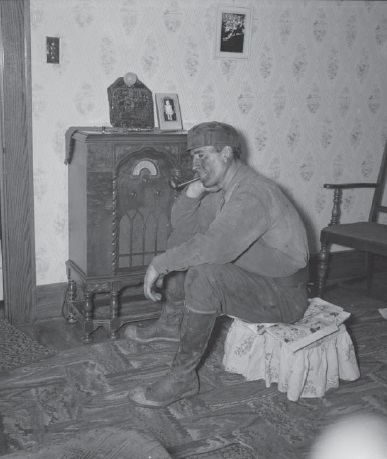
A more well-to-do miner listening to the radio when he returns home in the morning after working on the night shift. He is Polish, his wife Hungarian. These “foreigners” are generally thrifty and their houses are cleaner than those of “Negros” or “Americans”. Westover, West Virginia. Marion Post Wolcott, September 1938 (Library of Congress, Prints & Photographs Division, FSA-OWI Collection, LC-USF34-050293-E). This young miner reminds me of Steve Soltis, as he might have looked as a young man. Steve was Slovak and Polish; he was my grandmother’s nephew.
In the fashion of the times, the fate of the five sisters was tied to their men. Ann, Mildred and Mary married miners who lived in western Pennsylvania; Peg and Trudy married men who worked in Youngstown. Their fates were to be more varied than those of the brothers. Mary, Peg and Trudy lived long lives (Trudy is still living), although Peg was abused by her husband; Ann died in childbirth; and Mildred, also abused by her husband, went insane and died in a mental institution after living there for decades. Mildred’s children, adopted away, are lost to the family. Poems in Passage tell these stories.
Of these husbands, the one I knew best was Uncle Bus Brown, a miner. We visited him, and Aunt Mary, in their former company house in Revloc, Pennsylvania, as often as we could. In one of my earliest poems, I tried to convey a sense of this admirable man:
UNCLE BUS
Brick-patterned
tar-paper town
ringed by boney piles
smoking from their weight.
Uncle Bus lived there.
Remembered in a photo:
Bus home from the mine,
raccoon-eyed, slumped.
Taken in bad times – wife, three
kids, two days work a week.
Thirty years on, I loved to visit,
to haunt the cast cement-block
store and post office,
to trace the intricate, rusty
ironwork of the tipple.
One time, I dragged things
home to Bus’s: lard
bucket, coat hanger. Junk.
Strung them on a guy-wire:
tipple buckets lifting coal.
No dice. Bus – only time
I saw him angry –
made me haul it all away.
Idle hands are the
devil’s workshop.
Bus didn’t understand.
Or maybe, just maybe,
he didn’t see a reason
to play at building
the mine.
Now – coughed and gone –
my uncle, the mine, the
whole bloody mess. Only
the stilled town and its
boney piles, smoking, remain.
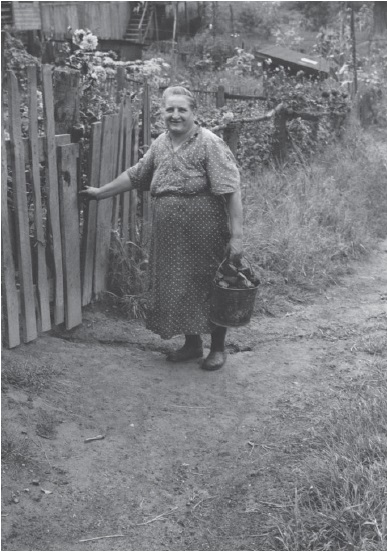
Hungarian miner’s wife bringing home coal for the stove from slate pile. Coal camp, Chaplin, West Virginia. Marion Post Wolcott, September 1938 (Library of Congress, Prints & Photographs Division, FSA-OWI Collection, LC-USF33-030308-M4). The boney pile had at least some value for people living in the coal mining towns when coal was still used for the kitchen stove and the home fireplace or furnace.
Bus (short for Buster Brown), who was an immigrant himself, having come to the US from Scotland, suffered a stereotypical miners’ fate, dying of black lung in 1980. My father asked me to go to the funeral with him (this was while I was a freshman in college), and I did. It was at this time that the drastic contrast between the dying coal towns of Pennsylvania and the rapidly growing Research Triangle area of North Carolina, where I lived then and now, really began to strike a nerve in me. I tried to capture this feeling in a much more recent poem that is also intended as a follow up to “Uncle Bus”:
BUS BROWN’S FUNERAL
Seventies tin-box car
crawl-climbs peaks, snakes
the Shenandoah vale, past
Winchester Blue and Gray
Motel, west of Broad Top
to tiny coal town.
At ex-company house,
whiff of boney-pile smoke
as women and men gather
to lay Bus
in the ground.
This black-lunged man
who labored in the Earth
each workday –
or two days a week in Hoover times.
It’s a long road from Auld
Reekie brought this man, chest
wizened like a dried apple,
to a churchyard undercut
by company tunnels.
Where no one can stop
the craters swallowing lawns,
playgrounds as dark rocks
shift far below.
That is the story of my grandfather and his generation, and the generation represented by his children, nieces and nephews. The story of the following generation, my generation, is one largely of assimilation, and disengagement from the past. One of my sisters, and my wife Caroline and I, have been to Slovakia and Hungary; in fact, Caroline and I have been three times and plan to go back again in a year or two. The poems in the last section of Passage tell some of what we found when we visited Hungary and Slovakia three times in the decade that followed the fall of the Iron Curtain/Berlin Wall (i.e., in 1994, 1996 and 1997).
None of my Revy/Reevy cousins have been to Central Europe, and neither of our children, the next generation of our family, have yet been there. Our children haven’t been back to western Pennsylvania in over a decade, either. Except for my sister, my wife and me, the disengagement of the Reevy/Revy family from its heritage is dramatic and nearly complete. In one of the poems in Passage, I try to express this disengagement in concrete terms:
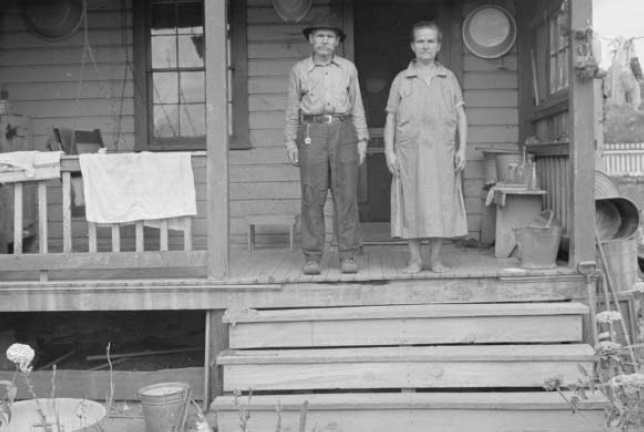
Hungarian miner, Calumet, Pennsylvania. Worked in the mines for thirty-four years, now sixty-three with no pension and no work. Ben Shahn, October 1935 (Library of Congress, Prints & Photographs Division, FSA-OWI Collection, LC-USF33-006007-M5).
HOUSECLEANING
Flames rise from steamer trunk
in the backyard – oldest
daughter piles on papers, mildewed
needlework, her father’s pipe.
Farmhouse needs a good scrub
now that Ma’s gone;
and Pap, alone at the end,
in an old-folks’ home.
Toss on the refuse – passports,
photos, deeds to houses farms mines
long since sold.
Postcards – the ship that brought
them over, harbour at Fiume
– flip into the fire.
They curl, vent foul-smelling
spume, light –
fly off in a wisp
of bitter ash.
The story I outline in this essay, then, is the story of the family mirrored by the poems in Passage. And, for a family deriving from Central European immigrants who came to the United States during the great wave of blue-collar/working class immigration that fell between the influx of immigrants fleeing the revolutions of 1848, but came before those dislocated by World War II and its aftermath, it is a typical one.
That is the fate of the people, but what of the places? As miners, my family lived in the towns I mentioned above: Barnesboro, Nanty Glo, Revloc, Spangler, Thirteen. Then, as farmers, Stefan Révay and his family moved to a rural area just outside the town of Ebensburg, the county seat of Cambria County.
First, these are not places that Americans typically visit, if they do not live in these communities already. Nearby Johnstown, Pennsylvania, gets some heritage tourism based largely on the famous Johnstown Food of the 1880s, and Altoona welcomes railroad enthusiasts seeking sites such as Horseshoe Curve and the Railroaders Memorial Museum. The closest major US city is Pittsburgh, about seventy miles west of Ebensburg. I have not visited these places in over ten years. Few people in North Carolina, where I now live, would recognise the names of any of these communities, except for the city of Pittsburgh.
Second, the virtual death of the deep-mine coal mining industry(13) has utterly transformed these towns; except for Ebensburg, which was and is a county seat rather than a mining town. As I mentioned already, the former mining camp of Thirteen is a totally vanished ghost town that I have been unable to locate. Barnesboro and Spangler experienced a fall in population as coal mining declined, and in 2000 they merged to form the borough of Northern Cambria.
Of these towns, I know Nanty Glo and Revloc best. Nanty Glo was where my father lived as a young boy and where my cousin Steve Soltis lived until his passing in 2003. As I remember it from childhood, Nanty Glo had an operating coal mine visible from the road as you drove into town from the south, a mine that was surrounded by smouldering slag heaps locally known as boney piles. The company houses even then had been sold to the miners or former miners living in them and did not look like the uniform company houses we see in Farm Security Administration photos of the Great Depression, or depicted in films such as “Coal Miner’s Daughter”.
Today, Nanty Glo is a pleasant small town with a declining population; in fact, the town’s population has declined in every US census since the census of 1940.(14) My mental image of the town is that it is occupied by retirees (like my cousin, Steve’s daughter, who still lives there), but this is not really correct; the median age of the residents is 42.
Revloc is perhaps the most interesting of these towns. As a small boy, other than Uncle Bus and Aunt Mary’s house, what I remember there is the classic company store, another building that I believe housed mining company offices, and, as in Nanty Glo, the towering, smouldering boney piles that surrounded the town in a man-made, isolating, malodorous vale. The last time I visited, Bus and Mary’s home, a former company house, was still there, as was the long-closed company store. The village is quiet, with a sense of just holding on; it is as if time stopped when the mines closed and the men walked home from work for the last time.(15)
I had my last visit to Nanty Glo in mind when I wrote “Black Land”, but the town described here could be any former mining town in the coal regions of American Appalachia:
BLACK LAND
On the edge
of town orange water
seeps from a dark
drift hole
rimmed by false
hills of boney tied
with rusted rails
to nothing.
Trees fringe clearcut
and slate lumps.
At least the mountain,
a honeycomb, still rises,
towers above houses
laid together, identical
shells cloaking
history under
vinyl, aluminium, stucco,
spots of festive paint,
added rooms, trellised
porches, shrines, lawns:
as demobilised regiments,
removing uniforms,
become patchwork,
human, again.
Is the decline of these towns, and of this particular extractive industry, progress? Do the dreams of the immigrants who came to these places to work in the mines make a difference today? I do not know the answers to these questions. The only answer I can give is to say, if you are interested in this history, you should visit these places, if you can, and decide for yourself.
Notes: A general note on the photos: the photos here are all from the Farm Security Administration/ Office of War Information collection held by the (US) Library of Congress. The author also writes frequently about the Farm Security Administration/Office of War Information photographers, who included Ben Shahn, Jack Delano, Walker Evans, Dorothea Lange, Arthur Rothstein, Marion Post Wolcott and many others of note. From 1935 to 1943, the Historical Section of the Resettlement Administration/Farm Security Administration/Office of War Information captured images of America during the Great Depression and World War II. There are many books that give a general introduction to this impressive portfolio of work; for an example, see Gilles Mora and Beverly W. Brannan, FSA: The American Vision (New York: Abrams, 2006). The images may be accessed on the Library of Congress website at http://www.loc.gov/pictures/collection/fsa/ (black and white images) and http://www.loc.gov/pictures/collection/fsac/ (colour images).
A general note on sources about Hungarian immigration to the United States: there are a handful of books available on this subject. A short, general overview, if a bit dry and dated, is Steven Bela Vardy, The Hungarian-Americans (Boston: Twayne Publishers, 1985). A much more interesting read, albeit with an episodic structure, is found in Albert Tezla, editor, The Hazardous Quest: Hungarian Immigrants in the United States, 1895–1920 (Budapest: Corvina, 1993).
1 Notice how unstable family names were during this period of history in the United States.
2 Most notably the Immigration Restriction Act of 1924; see Vardy, The Hungarian-Americans, 93.
3 Until just a few years ago, these comments would also have applied to oil and gas extraction in the United States. Due to a technology known as hydraulic fracturing, or “fracking”, the long decline in the US oil and gas industry has suddenly, and unexpectedly, turned around. Historically, this industry has not been a major employer of Central Europeans.
4 Hungarians also often worked as butchers, according to stories told in my family.
5 This number does not necessarily include those of ethnic Hungarian ancestry from countries such as Croatia, Romania, Serbia and Slovakia. If you include this population as well, there may be as many as 4 million people with Hungarian ancestry in the United States.
6 See http://factfinder.census.gov/faces/tableservices/jsf/pages/productview.xhtml?pid=ACS_10_1YR
_DP02&prodType=table for more United States Census Bureau information. Accessed 25 May, 2015.
7 See http://ech.cwru.edu/ech-cgi/article.pl?id=H7, accessed 25 May 2015.
8 According to family stories, the name was changed when the children of the family entered public school in western Pennsylvania. Despite the legends of “Ellis Island names”, names were generally changed when immigrants interacted with schools or employers.
9 Unfortunately, I know them only from photographs. My grandmother died before I was born, and I never visited my grandfather in the old age home where he died when I was a very young child.
10 The site of the house in Dobsina is currently occupied by an Iron Curtain-era apartment building.
11 My father’s Ellis Island record may be found with the name “Stefan Revayova” at http:// libertyellisfoundation.org/passenger-result, accessed 25 May 2015. Due to this website, it is very easy to find Ellis Island manifest records for people who immigrated to the United States through Ellis Island. My grandfather entered the United States earlier, probably through Castle Garden, and my family has not been able to find his manifest/entry information.
12 The United States is currently suffering an epidemic of PTSD among the veterans of my country’s recent wars in Iraq and Afghanistan. For this reason, PTSD is now a common term in the US.
13 Strip mining and mountain-top mining survive in the bituminous regions of the eastern United States. These industries are centred in West Virginia. Mines such as this employ small numbers of workers compared to the old anthracite and bituminous “deep” coal mines.
14 For this data, see http://factfinder.census.gov/faces/tableservices/jsf/pages/productview.xhtml?src
=bkmk, accessed 13 June 2015.
15 In researching this essay, I was pleasantly surprised to see that Revloc is a Historic District listed on the (US) National Register of Historic Places. See http://www.livingplaces.com/PA/Cambria_ County/Cambria_Township/Revloc_Historic_District.html, accessed 27 June 2015.







You have to log in or registrate for writing comments.